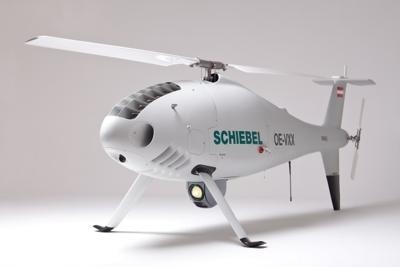Thu, Aug 28, 2014
Flying From Ship-Borne Migrant Offshore Aid Station
As part of the Migrant Offshore Aid Station operation the Schiebel Camcopter S-100 UAS (Unmanned Air System) is helping to save the lives of refugees in the Mediterranean Sea.

Desperate people fleeing conflict, economic desperation and violence in their homeland look towards Europe as a safe haven. They travel by all means possible for days or weeks on end to get to countries of transit from which they will sail out in makeshift sea craft. The lucky ones reach Europe where they can claim asylum, the unlucky ones perish.
MOAS was founded to take action to prevent such tragedies in the future and initiated Operation Phoenix where the Camcopter S-100 plays a vital role. A ship-borne aid station, named Phoenix, was made available to support refugee vessels in need. Phoenix has two 18-foot rigid inflatable boats on board that respond to calls for assistance.
The Camcopter S-100 is launched from on board the ship to locate and identify boats in distress. The UAS then provides imagery in real-time, day and night and even under adverse weather conditions. Operated by Schiebel personnel, the EO/IR camera submits essential data to locate people in need. With the help of the unmanned helicopter the Rescue Coordination Centre (RCC) can be informed and provide help immediately.
The mission radius was implemented in a strategic geographic location on the central Mediterranean route, affected by migratory flows departing from the southern Mediterranean littoral. Between August and October 2014, the 120-foot expedition vessel Phoenix will conduct three operations in central Mediterranean, each lasting two to three weeks.
“We are very happy to provide this capability and our experience for MOAS to help people in need," said Hans Georg Schiebel, Chairman of the Schiebel Group. "With our combined effort we can save the lives of refugees in the Mediterranean Sea and hopefully raise awareness for the situation of migrants worldwide.”
(Camcopter S-100 pictured in file photo)
More News
Aero Linx: Model Aeronautical Association of Australia MAAA clubs are about fun flying, camaraderie and community. For over 75 years, the MAAA has been Australia’s largest fl>[...]
Touchdown Zone Lighting Two rows of transverse light bars located symmetrically about the runway centerline normally at 100 foot intervals. The basic system extends 3,000 feet alon>[...]
“Discovery and innovation are central to our mission at Virgin Galactic. We’re excited to build on our successful record of facilitating scientific experiments in subor>[...]
How To Get A Story On Aero-TV News/Feature Programming How do I submit a story idea or lead to Aero-TV? If you would like to submit a story idea or lead, please contact Jim Campbel>[...]
Student Pilot Reported That During Rotation, “All Of A Sudden The Back Of The Plane Kicked To The Right..." Analysis: The student pilot reported that during rotation, “>[...]
 ANN's Daily Aero-Linx (05.02.24)
ANN's Daily Aero-Linx (05.02.24) ANN's Daily Aero-Term (05.02.24): Touchdown Zone Lighting
ANN's Daily Aero-Term (05.02.24): Touchdown Zone Lighting Aero-News: Quote of the Day (05.02.24)
Aero-News: Quote of the Day (05.02.24) ANN FAQ: Contributing To Aero-TV
ANN FAQ: Contributing To Aero-TV NTSB Final Report: Cirrus Design Corp SR20
NTSB Final Report: Cirrus Design Corp SR20



